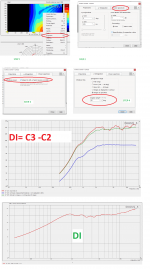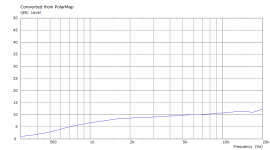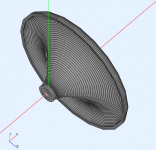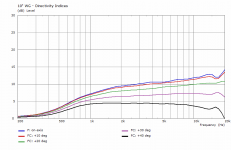Nice! 🙂 Was that intentional?
Probably you could stop the rolling up well before it becomes impractical without losing much of the smoothness.
Probably you could stop the rolling up well before it becomes impractical without losing much of the smoothness.
Yes, I did.
There is a trick, that allows you to calculate acoustic power response and DI using VACS just in few clicks. Firstly, you need set "Farfield" condition in the Spectrum script to calculate the Contour plot in VACS.
Code:
BE_Spectrum
PlotType=Arc
GraphHeader="nonnormalized"
BodeType=LeveldB; Range=50
PolarRange=-180, 180, 72
BasePlane=xy
Farfield
100 Inclination= 0.0 ID= 2000When the Contour plot is calculated in VACS, click the right mouse button on it, select "Projection..." --> "Power spectrum" tab and set tick to calculate acoustic power response and adjust it to the point source SPL. In the the "y-Integration" tab select desired angle to average SPL. Then you can calculate DI simply as difference ("Processing"->"Calculates curves n->1"...) of averaged SPL and Adjusted power response to the point source.
P.S.
Similarly, you can calculated DI of any non-symmetric 3D source by using "Baloon" graph.
Attachments
It wouldn't be any better for the horn, that's for sure. But it would reduce the diffraction (maybe) and early reflections (probably) coming from the woofer.Why would you do that? It would make it worse, not better. Just use it as freestanding, smoothly terminated all around the horn - it can't be any better.
- You have no idea how making it non-symmetric complicates the simulation. It would take maybe 200 - 500x more time to calculate that in a reasonable resolution.
There is a trick, that allows you to calculate acoustic power response and DI using VACS just in few clicks. Firstly, you need set "Farfield" condition in the Spectrum script to calculate the Contour plot in VACS.
Thanks for that. I always wondered if it was possible.
I don't think this would be an issue. At least the measurements made so far didn't show anything special. They are better than ever, in fact. And the lower the crossover point the less of a problem this is.It wouldn't be any better for the horn, that's for sure. But it would reduce the diffraction (maybe) and early reflections (probably) coming from the woofer.
Last edited:
Thanks for that. I always wondered if it was possible.
I just need to note, that DI of a flat baffled piston has exact analytic solution and theoretically it's DI should not decrease below 3.01dB at very low frequencies. However, numerical VACS solution for the same model showed a slightly lower value, ~2.3dB, although otherwise the both analytic and numeric solutions were very similar (the results can be find in this post Acoustic Horn Design – The Easy Way (Ath4) ). It would be interesting to know why and where VACS lost ~0.7dB

Last edited:
Simulated DI (10 deg) for the 10" waveguide presented before (#3796), where it was taken for 0-90 deg only.

Attachments
I don't think this would be an issue. At least the measurements made so far didn't show anything special. They are better than ever, in fact. And the lower the crossover point the less of a problem this is.
At what XO is freestanding waveguide w rollback no longer better than waveguide on flat woofer baffle?
Last edited:
What seems to be the case is that in general the freestanding one won't be worse at crossover frequencies commonly used. And you wouldn't want to go higher than that anyway.
Last edited:
For, say a 12", do you have an idea of how much clearance needed between waveguide and woofer box below?
Or said differently, where should the mouth of waveguide be relative to the box below it?
Or said differently, where should the mouth of waveguide be relative to the box below it?
To align them in time the compression driver needs to be behind the woofer. By how much depends on the crossover frequency and LP filter slope. Mine is about 8 inches back and the woofer half that, crossover about 800 Hz. That's pretty close to give you an examples.
You can do a adjustment of the timing with the LP filter design.
You can do a adjustment of the timing with the LP filter design.
My favorite article on that question is this:
http://www.melaudia.net/zdoc/jml_crossovers_etf04.pdf
Here's an example of it in practice:
Crossovers, a Step Further | Page 6 | DiyMobileAudio.com Car Stereo Forum
http://www.melaudia.net/zdoc/jml_crossovers_etf04.pdf
Here's an example of it in practice:
Crossovers, a Step Further | Page 6 | DiyMobileAudio.com Car Stereo Forum
To align them in time the compression driver needs to be behind the woofer. By how much depends on the crossover frequency and LP filter slope. Mine is about 8 inches back and the woofer half that, crossover about 800 Hz. That's pretty close to give you an examples.
You can do a adjustment of the timing with the LP filter design.
The alignment applies to the acoustic centers, I suppose?
You (also) use DSP, as I recall, which should make things easier.
15" freestanding waveguide, 1" throat. Hmm, it's even better than I anticipated 🙂
What's the depth and is it 90°?
Last edited:
As I understood the question, it was more about a "mouth alignment" - how to minimize diffraction of the sound radiated by the woofer off the freestanding waveguide body. I used to think it would be a problem but now I don't think that any more.
Angular step is 5° as usual so it is somewhere between 80° - 90°. The depth was around 130 mm, IIRC.What's the depth and is it 90°?
Last edited:
The alignment applies to the acoustic centers, I suppose?
You (also) use DSP, as I recall, which should make things easier.
The acoustic center is ill-defined, so I avoid using this term. Just consider the physical distance from the diaphragm to the far field.
In the 100's (maybe > 1000) speakers that I have made only a half dozen or so were active - my own speakers included. But from my observations active is not worth the extra expense and complexity. I could measure small improvements but nothing substantial was noted audibly. If it wasn't so much trouble, I'd just go back to passive on my own system.
- Home
- Loudspeakers
- Multi-Way
- Acoustic Horn Design – The Easy Way (Ath4)




